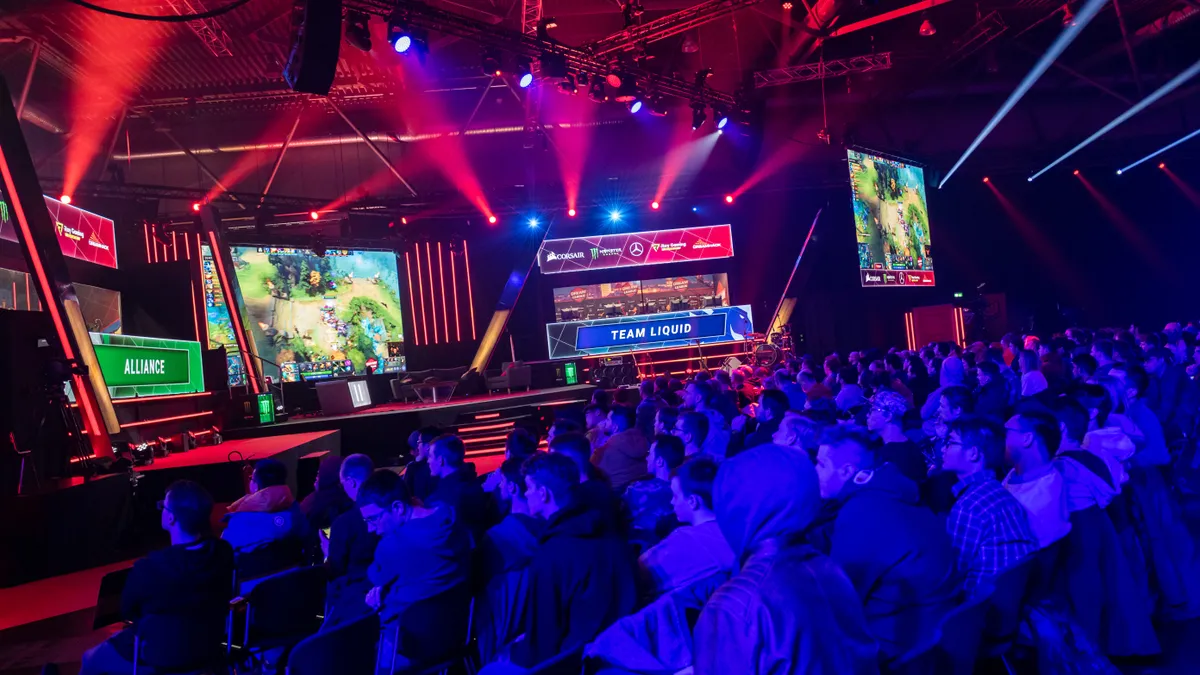Dive Brief:
- Despite catering to a largely virtual audience, the demand for brick-and-mortar esports venues will only grow in the next few years, according to a new report from real estate service firm JLL.
- Esports, or competitive video gaming, has often been written off across multiple industries, JLL noted, but the large audience and revenue are undeniable. Increasingly, fans of the various video gaming leagues look at the competition the same way sports fans have favorite teams and they want a place to cheer them on in person.
- A desire for a physical audience, a growing need for headquarters and league rule changes requiring that teams play in home cities will likely contribute to more esports focused venues built out in the near future.
Dive Insight:
2020 was not the best year for esports revenue, as it declined for the first time since data became available a decade ago, JLL reported. The dip was likely temporary, as 2021 is on pace for a record year with total industry revenue over $1 billion for the first time.
The largest driver of revenue for esports is corporate sponsorships — also a large contributor for professional sports leagues. Sponsors — which in the past have included Mountain Dew, Red Bull and video game companies themselves — support teams and venues and host events and competitions. Though ticket and merchandise sales decreased 37% from 2019 to 2020, the return of in-person events could contribute to growth in 2021 and beyond, the report notes.
Examples of esports venues, both built and planned, include:
| Stadium | Location | Size | Details |
|---|---|---|---|
| SURGE | Chicago | 108,000 square feet | Approved by Chicago's City Council in March. |
| Esports Stadium Arlington (ESA) | Arlington, Texas | 100,000 square feet / 2,500 spectators | Opened 2018, largest dedicated esports facility in U.S. |
| Fusion Arena | Philadelphia | 60,000 square feet / 3,500 spectators | Construction halted due to the pandemic. |
| The Fortress | Full Sail University, Winter Park, Florida | 11,000 square feet / 500 spectators | Largest collegiate esports arena in the country. |
| Esports Gaming Lounge | Butler University, Indianapolis | 7,500 square feet | Announced 2019, expected completion in fall 2022. |
| UCI Esports Arena | University of California Irvine | 3,500 square feet | Designed for student use. |
| Cedar Point Arena | Cedar Point, Ohio | 1,500 seats | Cedar Fair Entertainment plans to add to its amusement park by 2023. |
For an esports match, teams and players do not need to be in the same place to compete. Just like with professional sports, fans can go in person (such as the fans watching a Dota 2 competition in Leipzig, Germany, pictured above), or watch from home. The difference from other sporting events is that opposing teams, and in fact teammates, can play from their consoles and computers anywhere in the world. As a result, the ability for the competitions to continue during the pandemic was one reason why the real estate footprint has been slower to develop, said the report.
Nevertheless, fans have proved they respond to a hometown team, and some leagues, such as the Overwatch League, are implementing rules requiring teams to play in the towns in which they are based, which could impact construction, ticket sales and merchandise revenue.
In 2019, the Philadelphia Fusion, a team in the Overwatch League, announced plans to build Fusion Arena, designed by Populous. The 3,500-seat, 60,000-square-foot venue was set to become the largest of its kind in the U.S., but construction was paused in September 2021, due to the pandemic.
Venue types
Until now, venues have often focused on converted properties. Warehouses, conference centers or soundstages have been altered to provide a gathering space where the players can compete and spectators can watch. In the future, however, more venues may be specifically built for professional esports teams and their competitions, the report said.
For instance, Full Sail University has hosted events in its midsize converted venue dubbed The Fortress. Constructed within an existing building, the Fortress holds 500 spectators across 11,000 square feet.
Meanwhile, the largest standalone esports venue in the U.S. is Esports Stadium Arlington in Texas, a 100,000-square-foot, 2,500-spectator arena located near other professional sports venues in the city.
In addition, facilities to serve as headquarters for practice could spring up for professionals, universities and even high schools, as the industry grows.
Aside from those that provide a space for pro matchups, some esports real estate opportunities focus on recreational gaming.
Much like a classic arcade, gaming centers provide a venue for customers to walk in and pay to play. The difference is the amount of technology needed to support modern video games, in addition to the time spent playing individual games.
Sports bars or restaurants could also become venues for watching esports, both on TVs or on a smaller stage for local, in person events.














